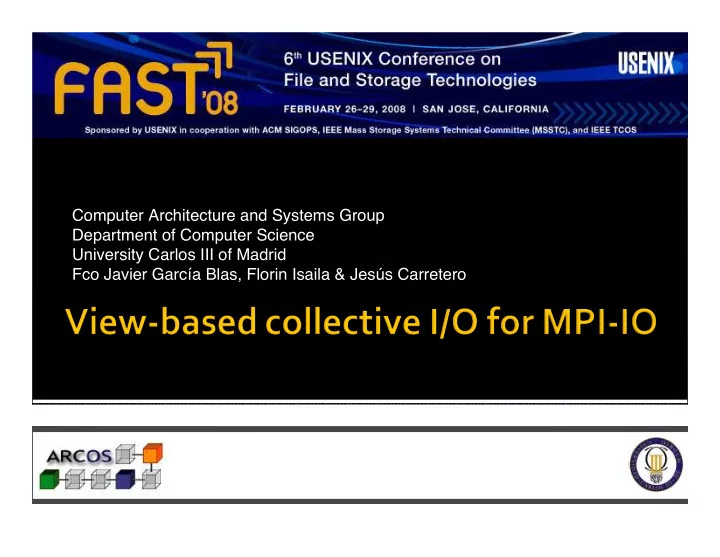

Computer Architecture and Systems Group Department of Computer Science University Carlos III of Madrid Fco Javier García Blas, Florin Isaila & Jesús Carretero
ϒ We propose and evaluate an alternative to the two-phase collective I/O (TP I/O) implementation of ROMIO called view-based collective I/O (VB I/O). ϒ View based I/O targets the following goals: Reducing the cost of data scatter-gather operations, Minimizing Minimizing the overhead of file metadata transfer, Decreasing the number of conservative collective communication and synchronization operations.
ϒ Differences between two-phase I/O and view-based I/O : At view declaration, VB I/O sends the view data type to aggregators, while TP I/O stores it locally at the application nodes. VB I/O assigns statically the file domain to aggregators, while TP I/O dynamically. At access time, TP I/O sends the offset-lists to the aggregators, while view I/O transfers only the view access interval extremities. The collective buffers of VB I/O are cached across collective operations. A collective read following a write, may find the data already at the aggregator. The collective buffers of VB I/O are written to the file system when the collective buffer pool is full or when the file is closed. For TP I/O , the collective buffers are flushed to the file system when they are full or at the end of each write operation.
Compute Node 3 Compute Node 0 Compute Node 1 Compute Node 2 Aggregator Node 0 Aggregator Node 1 Mapping phase Mapping phase Pool Pool Page 0 Page 1 Page 2 Page 3 Page 4 Page 5 Page 6 Page 7 Access phase Access phase
ϒ Evaluated on CACAU (HLRS Stuttgart) ϒ MPICH2 ϒ File system tested: PVFS 2.6.3 with 8 I/O servers ϒ The communication protocol of PVFS2 and MPICH2 was TCP/IP on top of the native Infiniband communication library ϒ 1 process per node ϒ View-based I/O had a collective buffer pool of maximum 64 Mbytes ϒ BTIO, coll perf and MPI_TILE_IO
ϒ Use 4 to 64 processes and two classes of data set sizes: B (1697.93 Mbytes) and C (6802.44 MBytes). ϒ BTIO explicitly sets the size of write collective buffer to 1 Mbytes ϒ The benchmark reports the total time including the time spent to write the solution to the file. ϒ However, the verification phase time containing the reading of data from files is not included in the reported total time.
Writes were between 89% and 121% Reads were between 3% to 109% Overral time was between 8% to 50%
ϒ Breakdowns: total time spent in computation, communication and file access of collective write and read operations, for class B from 4 to 64 processes. Two-phase I/O View-based I/O
Avoids the necessity of transferring large lists of offset-length pairs at file access time as the present implementation of two-phase I/O. Reduces the total run time of a data intensive parallel application, by reducing both I/O cost and implicit synchronization cost. The write-on-close approach brings satisfactory results in all cases.
Adding lazy view I/O Views and data are sent together in write/read primitives Views are sent if the aggregators do not have the data view Including two data staging strategies for prefetching prefetching and flushing flushing the collective I/O buffer cache: The prefetch is done in coordinate manner, by aggregating the view information of several processes and reading ahead whole blocks. Based on MPI-IO views. The flushing strategy allows for overlapping the computation and I/O. Reduces also the rates at which the buffer cache becomes full with dirty file blocks, which may clog the computation to go on. Currently: We have already implemented the mechanisms for enforcing these two strategies and are estimating the efficiency of this approach for large scale scientific parallel application. We are investigating the trade-off between the contradictory goals of promoting data by prefetching, demoting the data by flushing and temporal locality.
Recommend
More recommend